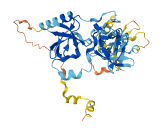Descriptions
Autoinhibitory domains (AIDs)
Target domain |
160-213 (N-SH3);230-283 (C-SH3) |
Relief mechanism |
PTM |
Assay |
|
Accessory elements
No accessory elements
References
- Yuzawa S et al. (2004) "A molecular mechanism for autoinhibition of the tandem SH3 domains of p47phox, the regulatory subunit of the phagocyte NADPH oxidase", Genes to cells : devoted to molecular & cellular mechanisms, 9, 443-56
- Yuzawa S et al. (2003) "Crystallization and preliminary crystallographic analysis of the autoinhibited form of the tandem SH3 domain of p47(phox)", Acta crystallographica. Section D, Biological crystallography, 59, 1479-80
Autoinhibited structure

Activated structure

1 structures for A6NI72
| Entry ID | Method | Resolution | Chain | Position | Source |
|---|---|---|---|---|---|
| AF-A6NI72-F1 | Predicted | AlphaFoldDB |
No variants for A6NI72
| Variant ID(s) | Position | Change | Description | Diseaes Association | Provenance |
|---|---|---|---|---|---|
| No variants for A6NI72 | |||||
No associated diseases with A6NI72
8 regional properties for A6NI72
| Type | Name | Position | InterPro Accession |
|---|---|---|---|
| domain | SH3 domain | 157 - 216 | IPR001452-1 |
| domain | SH3 domain | 227 - 286 | IPR001452-2 |
| domain | Phox homology | 1 - 126 | IPR001683 |
| domain | Neutrophil cytosol factor 1, C-terminal | 359 - 391 | IPR015039 |
| domain | Neutrophil cytosol factor 1, PBR/AIR | 293 - 340 | IPR032136 |
| domain | Neutrophil cytosol factor 1, PX domain | 6 - 124 | IPR034909 |
| domain | Neutrophil cytosol factor 1, first SH3 domain | 161 - 213 | IPR035756 |
| domain | Neutrophil cytosol factor 1, second SH3 domain | 231 - 283 | IPR035757 |
2 GO annotations of cellular component
| Name | Definition |
|---|---|
| cytoplasm | The contents of a cell excluding the plasma membrane and nucleus, but including other subcellular structures. |
| NADPH oxidase complex | A enzyme complex of which the core is a heterodimer composed of a light (alpha) and heavy (beta) chain, and requires several other water-soluble proteins of cytosolic origin for activity. Functions in superoxide generation by the NADPH-dependent reduction of O2. |
2 GO annotations of molecular function
| Name | Definition |
|---|---|
| phosphatidylinositol binding | Binding to an inositol-containing glycerophospholipid, i.e. phosphatidylinositol (PtdIns) and its phosphorylated derivatives. |
| superoxide-generating NADPH oxidase activator activity | Binds to and increases the activity of the enzyme superoxide-generating NADPH oxidase. |
2 GO annotations of biological process
| Name | Definition |
|---|---|
| respiratory burst | A phase of elevated metabolic activity, during which oxygen consumption increases; this leads to the production, by an NADH dependent system, of hydrogen peroxide (H2O2), superoxide anions and hydroxyl radicals. |
| superoxide anion generation | The enzymatic generation of superoxide, the superoxide anion O2- (superoxide free radical), or any compound containing this species, by a cell in response to environmental stress, thereby mediating the activation of various stress-inducible signaling pathways. |
7 homologous proteins in AiPD
| UniProt AC | Gene Name | Protein Name | Species | Evidence Code |
|---|---|---|---|---|
| O77774 | NCF1 | Neutrophil cytosol factor 1 | Bos taurus (Bovine) | SS |
| P14598 | NCF1 | Neutrophil cytosol factor 1 | Homo sapiens (Human) | EV |
| A1X283 | SH3PXD2B | SH3 and PX domain-containing protein 2B | Homo sapiens (Human) | EV |
| Q5TCZ1 | SH3PXD2A | SH3 and PX domain-containing protein 2A | Homo sapiens (Human) | SS |
| A8MVU1 | NCF1C | Putative neutrophil cytosol factor 1C | Homo sapiens (Human) | SS |
| Q09014 | Ncf1 | Neutrophil cytosol factor 1 | Mus musculus (Mouse) | SS |
| F1M707 | Ncf1 | Neutrophil cytosolic factor 1 | Rattus norvegicus (Rat) | SS |
| 10 | 20 | 30 | 40 | 50 | 60 |
| MGDTFIRHIA | LLGFEKRFVP | SQHYVRYMFL | VKWQDLSEKV | VYRRFTEIYE | FHKTLKEMFP |
| 70 | 80 | 90 | 100 | 110 | 120 |
| IEAGAINPEN | RIIPHLPAPK | WFDGQRAAEN | HQGTLTEYCG | TLMSLPTKIS | RCPHLLDFFK |
| 130 | 140 | 150 | 160 | 170 | 180 |
| VRPDDLKLPT | DNQTKKPETY | LMPKDGKSTA | TDITGPIILQ | TYRAIANYEK | TSGSEMALST |
| 190 | 200 | 210 | 220 | 230 | 240 |
| GDVVEVVEKS | ESGWWFCQMK | AKRGWIPASF | LEPLDSPDET | EDPEPNYAGE | PYVAIKAYTA |
| 250 | 260 | 270 | 280 | 290 | 300 |
| VEGDEVSLLE | GEAVEVIHKL | LDGWWVIRKD | DVTGYFPSMY | LQKSGQDVSQ | AQRQIKRGAP |
| 310 | 320 | 330 | 340 | 350 | 360 |
| PRRSSIRNVH | SIHQRSRKRL | SQDAYRRNSV | RFLQQRRRQA | RPGPQSPGSP | LEEERQTQRS |
| 370 | 380 | 390 | |||
| KPQPAVPPRP | SADLILNRCS | ESTKRKLASA | V |
